Purple color has to be mixed in situations when the required shade is not available in the palette or the necessary paint has run out. In the simplest case, mixing 2 or 3 colors is enough for this. To obtain a light or dark tone in different colors, you have to use different methods.
Characteristics and shades
In psychology, purple is associated with something unearthly and unknown, cosmic. Sometimes the color is associated with a feeling of melancholy, detachment. Because of associations with the unearthly, the color is related to religion, mentality, and is associated with wisdom and humility. In the creative environment, the color belongs to those who embody new ideas.
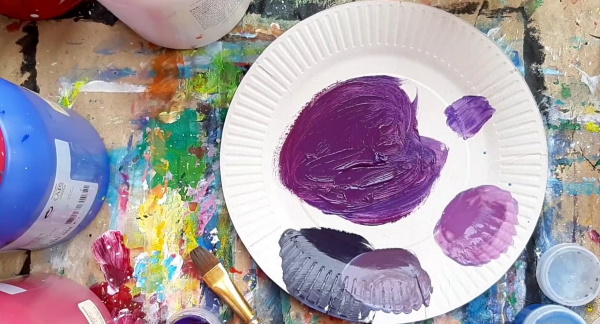
Purple color affects the subconscious of a person hypnotically, directs a person's gaze inward, into the subconscious. When observing this color, breathing and heartbeat become slower. People who prefer purple tend to fall under someone else's influence, but also like to manipulate others.
Purple can be mixed from 2 primary colors - red and blue, but depending on the predominance of one of them or the addition of a 3rd color, purple has different shades from light and pale to dark and saturated. There are almost 200 varieties of purple shades in total, and each of them has its own name for the convenience of artists and designers.
Most often, shades of purple are divided into categories:
| Violet | Tone of color | Names of shades |
| pastel | · light purple; · purple snow; · ice orchid; · gray-lilac; · lavender mist and others | |
| lilac | · lilac;
· fragrant purple; · victorious orchid; · pink lavender; · lavender pastel and others | |
| pink-purple | · purple haze;
· orchid; · a bouquet of orchids; · purple souvenir; · dusty pink and others | |
| purple | · lavender;
· mystical lilac; · lavender shade; · the color of the cosmic sky; · languid lavender and others | |
| red undertone | · purple color;
· Polignac pink; · smoky orchid; · purple orchid and others | |
| wine purple | · plum wine;
· hawthorn rose; · purple quartz; · prunes; · grape nectar and others | |
| medium purple | · purple chalk;
· hyacinth; · amethyst orchid; · purple paisley and others | |
| grey-violet | · glycine;
· lavender atmosphere; · family lilac; · thistle inflorescence and others |
Mixing rules
You can mix purple in the classic version from 2 primary colors - red and blue. To get a pure color, without a dirty, gray or brown undertone, do not add yellow paint when mixing. Depending on the saturation of red or blue, the final purple shade may change and be warmer or colder.
The following tools are used in the mixing process:
- a white plastic palette so that the shades are not distorted when mixed;

- set of paints (red, yellow, blue, green, white and black);
- brushes;
- a container with water, which is changed periodically so that the brushes do not get clogged;
- rough canvas for testing brushstrokes.
In the process, you can replace the tools with other materials at hand. The main criterion is the cleanliness of the containers, so that when mixing, the paint tone is obtained without impurities.
To get the desired shade of purple after mixing the primary colors, make a correction:
- You can make the tone lighter by using white or diluting the paint with water. Make sure there is not too much water, otherwise you can ruin the paper or other material and get streaks.
- You can make the tone darker by using black paint. It is introduced carefully and in small quantities, otherwise the violet tone may acquire a dark gray shade. To avoid this, indigo is used instead of black if possible.
- A delicate lavender shade is achieved by gradually adding grey.
- You can make the tone richer and more saturated with warm pink. Depending on its amount, you get colder or warmer shades of purple (grape, amethyst, etc.).
- Dark shades of wine, berry and eggplant are obtained by reintroducing red to purple.
- A bright plum shade is obtained by diluting dark purple with red.
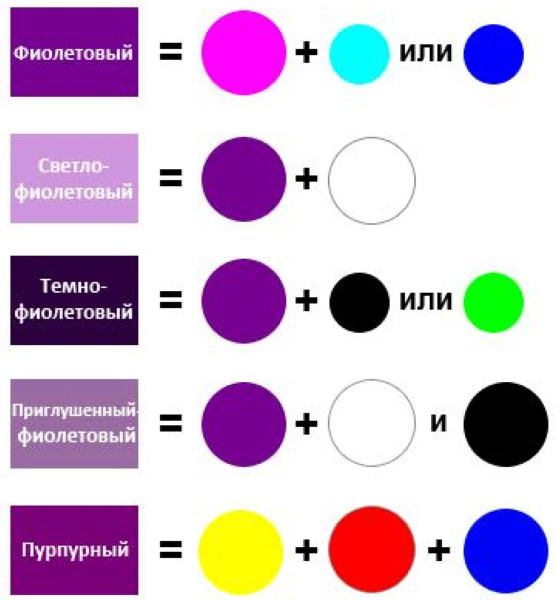
- A lilac-blue pastel color is obtained by combining violet and blue. The finished color is diluted with white.
From the primary colors
Purple can be mixed from red and blue, or from tones containing these colors. The main rule when creating purple is to exclude yellow, which gives a brown undertone.
When combining two basic colors (red and blue), the result is paler than the original paints. If the color is additionally lightened or darkened, the purple becomes even paler. Therefore, artists recommend working with a ready-made purple color in the palette to obtain the desired tone.
Classical
Classic purple color is obtained by mixing:
- blue with red;
- blue with red.

In this case, the proportion 2:1 is observed. If blue is used instead of blue, then purple turns out darker. Then black, white, pink, blue and other tones without a yellow tone are mixed into the finished color to bring out the desired shade.
Dark purple
To obtain a dark shade of purple, mix:
- blue with red;
- dark blue with red;
- indigo, lilac and red;
- black with red.
The saturation of blue absorbs red, even if the classic proportion is changed. Adding red in this case can give eggplant shades. If dark purple is diluted with white, then the lightest version of the tone is a gray-red-violet shade.
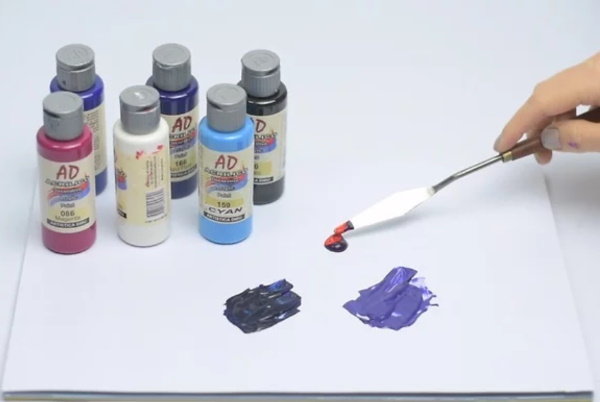
A rich dark purple is obtained by mixing it with black. In this case, the dark component is added carefully and in small quantities to avoid a dirty undertone.
The combination of indigo, lilac and red gives a bright shade. The warmth of the finished shade and its tone depend on the proportions of each original color. Choose the proportion at your discretion.
Light purple
Light purple shades are obtained by mixing the following colors:
- violet and white;
- purple with water;
- blue and pink;
- lilac and red.
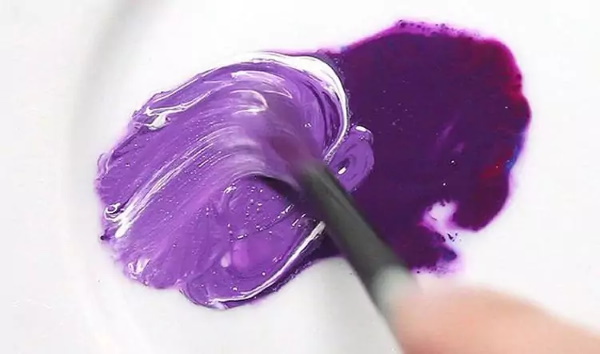
The simplest way to lighten purple is to add white. It is gradually mixed into the main purple until the desired tone is obtained. The result is checked on the palette, since the tone may differ during the mixing process and on the material. Artists recommend not to exceed the proportion of purple to white 1:5, otherwise the main color may be lost.
You can lighten purple by 1-2 tones by adding a small amount of water. This way the tone remains saturated, but lighter.
More complex shades of light purple are obtained by mixing blue and pink tones. Blue is considered the main color, and pink is added gradually until the desired tone is obtained. The colder the shade of pink, the paler the purple undertone will be. To obtain light purple with a red undertone, lilac is mixed as the main shade and a small amount of red. If you add a little more blue, you get berry shades.
Medium purple
The medium violet shade is sensitive to the addition of other shades, so they try not to dilute it with other colors. The medium shade is obtained by combining red and blue.
From different types of paints
Mixing purple regardless of the chosen paints will work when combining homogeneous paints (only gouache or only acrylic). If paints of different texture or quality are mixed, the finished result will be blurry or uneven. For mixing, artists recommend using paints from the same set so that they match each other as much as possible.
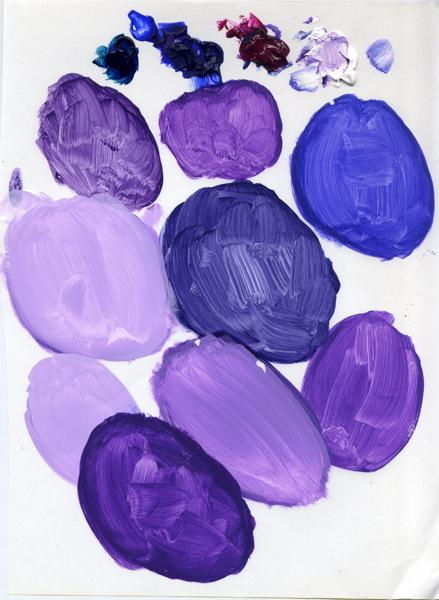
When mixing purple, one also takes into account the thickness of the paint, its wateriness or oiliness, the saturation of the original colors and other initial parameters that affect the final tone of purple.
Gouache
To obtain purple shades when working with gouache, follow the algorithm:
- Apply blue or light blue color to the palette.
- Mix in pink or red until the desired shade is achieved.
- The finished tone is lightened with white or darkened with black.

When working with gouache, there are important rules to follow that affect obtaining the desired tone:
- Gouache is not mixed on paper. Use only a clean plastic or glass container, preferably white.
- The shade is not adjusted using water.
- White and black colors are added in small quantities.
- Black can be replaced with dark green.
- Gouache can be mixed with black and white at the same time to obtain a dull tone.
- For brightness, a drop of yellow can be added to gouache, which produces a purple hue. This is the only mixing method where yellow can be used.
Acrylic paints
Mix acrylic paints to obtain purple shades using the following steps:
- Apply the main color – blue or light blue – to the palette.
- Additional color – pink or red – is added in small portions.
- Correct the color with black or white.
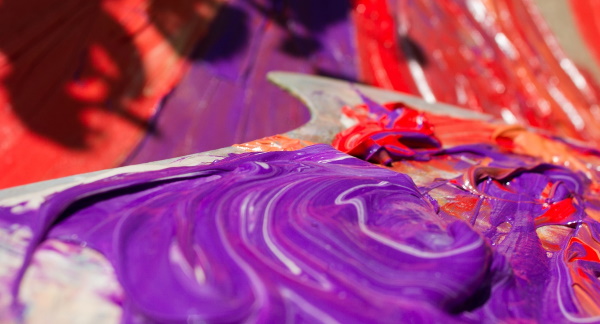
When mixing acrylic paints, follow these rules:
- It is difficult to calculate the proportions of acrylic paint, so all shades are added in small doses.
- Acrylic paints change tone after drying, so before using, make test strokes on a rough canvas and wait for the paint to dry.
Watercolor
You can mix purple color with watercolor paints by following the advice of artists and designers:
- Watercolor can be mixed both on the palette and on paper. If you mix paints on paper, then make rough strokes or mix paints immediately during the drawing process.
- Lighten watercolors with water.
- A dark shade is achieved by mixing it with red, black, pink or dark blue.
- Only pure colors, without inclusions and streaks, are suitable for mixing watercolor paints, otherwise the finished purple shade may turn out with a gray or brown undertone.
- Watercolor colors deteriorate quickly when mixed, so it is recommended to mix as few shades as possible.
Oil paints
Oil paints are considered the least suitable for mixing due to their viscous and thick consistency.
Choose the most convenient way for you to mix this type of paint:
- Physical process. The required original paints are mixed in a separate container until the desired tone is obtained. If necessary, the original color is added to adjust the tone. As a result of manual mixing, a new tone of paint is obtained. This process requires careful mixing so that there are no inclusions, uneven spots, or missed areas of paint. This method is considered the most common and simple.
- The process of applying paint directly to the canvas. First, the main color is applied and then an additional thin layer is applied on top. This is a complex technique that is rarely used by beginners due to insufficient experience with the glazing process.
- Optical color mixing. With this technique, strokes of different colors are applied as close to each other as possible at the same angle. From the side, it seems that the strokes merge and an even tone is obtained, which creates the effect of mixing two colors.
Pencils
Classic purple can be obtained by mixing pencil colors - blue and red. To do this, apply light shading with a blue pencil on the sheet. Then go over it with a red pencil, repeating the direction of the strokes.

They try to start shading with a light pressure, so as not to overdo it with some dye. When the necessary shade is obtained, the shading area is shaded.
Plasticine
To get the purple color of plasticine, also mix 2 primary colors - blue and red in equal quantities. Each color is kneaded separately for some time so that it becomes soft and warm. Then mix both colors until smooth. This process can take several minutes, since the thick mass is more difficult to mix than liquid paints.
Pros and cons of mixing yourself
Mixing paints yourself does not always lead to the desired result. Depending on the type of material, the mixing process may take different amounts of time.
In what cases is it beneficial to mix paints to get purple:
- When painting on canvas, you may need different shades and undertones of purple to show depth and saturation of the color.
- Leftover paint after renovation can be used to implement details of the intended design.
- The required shade of purple is missing from the palette in stores.
- It is convenient to tint paint in special machines to obtain a unique color and use it for design or decoration purposes. This method is convenient for painting a large room.
- When using paints for artistic purposes, experts often prefer the method of mixing colors in order to save material. With this method, they mix and use as much paint as is needed at the moment. There is no need to buy separate tubes.

In what cases is it better to use ready-made purple dye:
- In case of painting walls or a section of a wall purple, you should not buy separate components to mix. There is a large selection of color palettes in purple shades for painting walls, so you can use ready-made dye.
- When dyeing hair, experts do not recommend mixing components, even those that are close in shade, unless this is permitted by the instructions.
- Paint tinting is a complex process, which makes it difficult to get the exact desired shade. The downside of this process is that the machine cannot create a unique color, since the color is created according to a given program. The machine can create a tone that is entered into the program.
- During the mixing process, there are cases of paint contamination with other inclusions, which can add a brown or gray undertone. This is avoided by thoroughly washing all containers and tools for mixing paints.
Mixing purple may not be beneficial if more than 2 secondary shades are used in the process. Experts advise to always leave a reserve of base colors for one batch of paint to recreate the required shade.
If the paint set already includes pure violet, it is recommended to work with it. The shades obtained in the process of mixing with pure violet are always more saturated and less pale than those obtained by mixing the base colors.
Video on how to mix purple color
How to mix a beautiful purple color:
